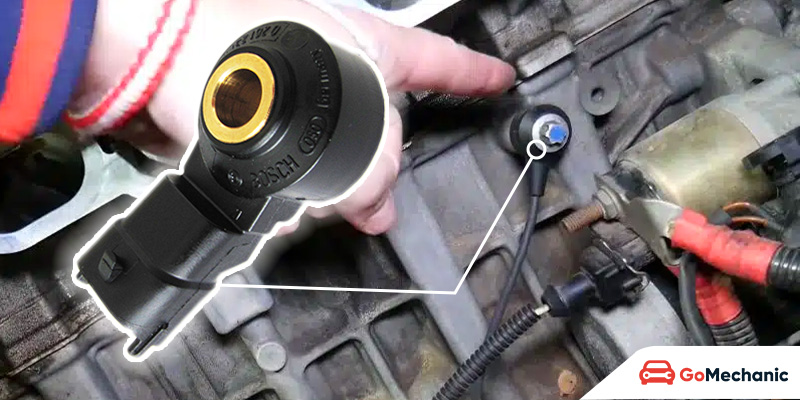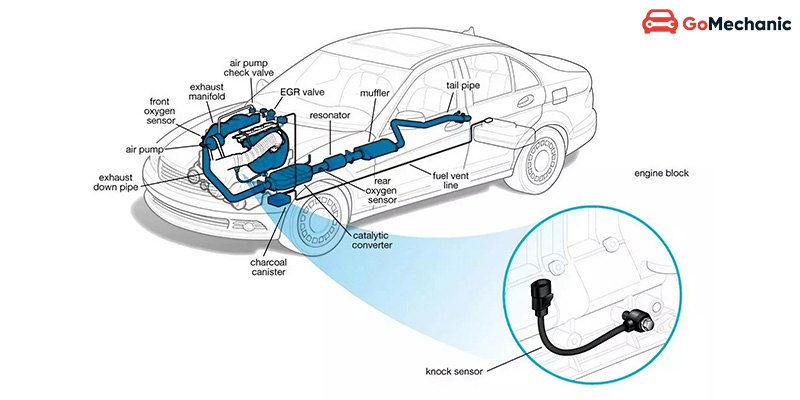Introduction to Knock Sensors
In the domain of making cars function better, engineers are always trying to improve how engines work. One important tool they use for this is called a knock sensor. It’s a small but really important device that helps engines run smoothly and efficiently.
Understanding Engine Noises
Strange engine noises like knocks, pings, and hisses occur when fuel doesn’t burn correctly, often due to low-quality fuel or engine strain. Gasoline engines may knock from low-octane fuel, while hissing suggests vacuum leaks. Diesel engines rattle from high compression and whine from turbocharger issues. Hybrids may whine during acceleration, and alternative fuel engines might backfire if the fuel mixture is incorrect. These noises can harm the engine if persistent, affecting performance and causing long-term damage.
The Role of Knock Sensors in Engine Performance
- Detecting Engine Noises: Knock sensors are specifically designed to detect these engine noises in real-time. By continuously monitoring engine vibrations and sounds, knock sensors can identify the early signs of detonation or pre-ignition.Knock Sensorsengine performance
- Preventing Engine Damage: Upon detecting abnormal engine noises, knock sensors send signals to the engine control unit (ECU), prompting it to adjust parameters such as ignition timing and fuel mixture to prevent potential damage to the engine.
How Knock Sensors Work
Knock sensors detect abnormal combustion, or “knock,” in internal combustion engines. This happens when the air-fuel mixture ignites unevenly, causing pressure spikes that can harm the engine. The sensor, usually placed on the engine block or cylinder head, senses vibrations caused by the knock. It then sends a signal to the engine control unit (ECU), which adjusts settings like ignition timing or fuel mixture to prevent damage.
- Sensor Location: Knock sensors are typically mounted on the engine block or cylinder head, close to the combustion chambers, to detect vibrations caused by engine knock.
- Sensing Mechanism: Knock sensors utilize piezoelectric crystals that generate an electrical signal in response to mechanical vibrations caused by engine knock. These sensors detect abnormal combustion and send signals to the engine control unit for adjustments to prevent damage.
Types of Knock Sensors

- Piezoelectric Knock Sensors: Piezoelectric knock sensors generate electrical signals in response to mechanical stress, making them highly sensitive to even slight engine vibrations.
- Resonant Knock Sensors: Resonant knock sensors detect and analyze engine noises precisely by resonating at specific frequencies when engine knocks occur.
- Hall-Effect Knock Sensors: Hall-effect knocks sensors detect changes in engine vibrations using magnetic fields, providing a reliable and efficient method for detecting knock events.
Benefits of Using Knock Sensors
- Improved Fuel Efficiency: Knock sensors maximize fuel combustion efficiency by optimizing ignition timing and fuel mixture.
- Enhanced Power Output: Knock sensors enable engines to operate at peak performance levels by preventing engine knocks, resulting in increased power output.
- Protection Against Engine Damage: Knock sensors help prevent potential damage to engine components by promptly detecting and addressing abnormal engine noises.
Challenges in Knock Sensor Implementation
- Calibration Issues: Ensuring accurate calibration of knock sensors is crucial to achieving optimal performance and reliability.
- Environmental Factors: External factors like temperature and humidity can influence the sensitivity and responsiveness of knock sensors.
Maintenance and Care for Knock Sensors
- Regular Inspection: Regularly inspect knock sensors to ensure they’re securely mounted, free of damage like cracks or corrosion, and have clean electrical connections. This helps catch problems early and ensures optimal engine performance.
- Cleaning Procedures: To clean knock sensors, use an automotive cleaner and a soft brush to remove dirt and debris. Avoid harsh chemicals or abrasive materials. Regular cleaning maintains sensor performance and prevents potential issues from contamination.
- Replacement Guidelines: Replace knock sensors according to manufacturer guidelines. Replace them if they’re damaged or if engine performance suffers. Regular replacement ensures the engine runs smoothly and prevents potential problems caused by worn-out sensors.
Knock Sensors in Modern Automotive Technology
- Integration with Engine Management Systems: In modern automotive technology, knock sensors integrate with engine management systems, monitoring engine vibrations for knock or detonation. They promptly signal the engine control unit (ECU) to adjust parameters, optimizing performance and preventing damage.
- Future Developments: Future knock sensor developments will prioritize sensitivity, durability, and adaptability for precise detection of knock, enhancing performance and fuel efficiency. Engineers will employ advanced materials for tougher sensors and integrate AI and machine learning for predictive maintenance and optimized engine performance.
Can knock sensors be retrofitted to older vehicles?
Yes, knock sensors can be retrofitted to older vehicles, but it depends on the vehicle and engine configuration. Aftermarket kits or engine modifications may be needed. Retrofitting can enhance performance, efficiency, and engine longevity by enabling the ECU to prevent knock.
Knock Sensors in Performance Tuning
- Optimizing Engine Performance: In performance tuning, knock sensors optimize engine performance by monitoring vibrations and detecting knock. Tuners adjust ignition timing and fuel delivery for maximum power output while maintaining engine reliability. These sensors enable real-time adjustments, helping enthusiasts achieve the ideal balance between performance and reliability.
- Fine-Tuning for Specific Applications: Knock sensors fine-tune engine performance for specific applications in tuning. By monitoring vibrations and detecting knocks, they allow precise adjustments to ignition timing and fuel delivery, optimizing power output while maintaining reliability for tailored performance.
Real-World Examples of Knock Sensor Applications

- Automotive Engines: Knock sensors in automotive engines prevent damage from detonation by monitoring vibrations. They enable the ECU to adjust ignition timing and fuel injection for optimal performance while preventing knocking.
- High-Performance Tuning: In high-performance tuning, knock sensors adjust engine parameters like ignition timing, fuel delivery, and boost levels to maximize power output while ensuring reliability for racing or high-performance street driving.
- Marine Engines: In marine engines, knock sensors prevent damage from knock and optimize performance for harsh conditions like recreational boating or commercial fishing.
- Power Generation: In power generation systems like gas turbines and generators, knock sensors detect and prevent combustion knock, ensuring reliable and efficient power production.
- Industrial Equipment: In industrial equipment like compressors, pumps, and generators, knock sensors monitor combustion to prevent damage from knocking, optimizing performance and reliability.
Common Myths and Misconceptions about Knock Sensors
- They are unnecessary: Some believe knock sensors are unnecessary or only for high-performance engines. In reality, they’re vital for preventing engine damage in all vehicles.
- They decrease performance: There’s a misconception that knock sensors reduce engine performance by retarding ignition timing. However, they optimize performance by preventing damaging knocks.
- They eliminate engine knock completely: Knock sensors can reduce knock, but they can’t eliminate it. Occasional knocking may still occur due to extreme conditions or engine issues.
- They don’t need maintenance: Knock sensors may wear out and need maintenance or replacement over time. Ignoring them can cause decreased engine performance or damage.
- They always trigger warning lights: Some believe knock sensor issues always trigger dashboard warning lights. However, minor sensor malfunctions may not immediately trigger alerts, leading to unnoticed performance issues.
Conclusion
This blog explores the importance of knock sensors in optimizing engine performance by detecting detonation and pre-ignition. It discusses their working mechanism, types, benefits, challenges, and maintenance, emphasizing their role in preventing engine damage. The post covers various sensor types and their functionalities, addressing calibration challenges and environmental factors. It advises regular maintenance and highlights their integration into modern automotive technologies, debunking common myths.





